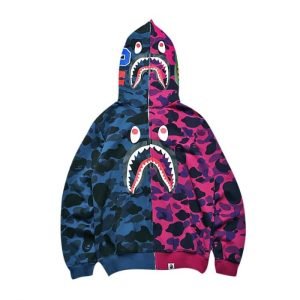
The world of streetwear has long been dominated by a few elite names, and one brand that consistently stands out is A Bathing Ape, Bape Hoodie more commonly known as BAPE. Since its inception in 1993 by Japanese designer Nigo, BAPE has created a global following rooted in its audacious designs, limited-edition drops, and premium quality. Among its most iconic creations is the BAPE Tiger Hoodie—a garment that fuses bold visual identity with deep cultural impact.
Origins of the Tiger Hoodie
BAPE’s Tiger Hoodie made its debut in the early 2000s, during a period when the brand was gaining immense popularity outside of Japan. It quickly became one of the most recognizable and coveted pieces in street fashion. The hoodie wasn’t just another piece of outerwear—it was a statement. With its ferocious tiger face emblazoned across the hood and sharp, contrasting colors, it immediately turned heads and sparked conversation.
This design took direct inspiration from Japanese pop culture, anime, and American street style. The fierce tiger motif, paired with military influences and bold lettering like “WGM” (World Gone Mad), created a perfect storm of rebellion and high-fashion sensibility.
Aesthetic That Defies Subtlety
The BAPE Tiger Hoodie doesn’t aim to blend in. It’s loud, deliberate, and daring. What makes the design so captivating is the full-zip hoodie construction that extends all the way through the hood. When zipped up, the tiger face on the hood aligns perfectly, giving the illusion of the wearer becoming one with the beast.
Typically, the hoodie features an asymmetrical mix of patterns and elements—camouflage prints, embroidered patches, and vivid colors like orange, green, red, and blue. The tiger’s eyes, nose, and teeth are designed with intricate stitching and fabric layering that enhances the hoodie’s 3D effect. It’s not just screen-printed; it’s meticulously constructed for texture and depth.
Cultural Influence and Celebrity Endorsement
The popularity of the BAPE Tiger Hoodie exploded in the West thanks in part to its adoption by hip-hop artists and celebrities. Icons such as Pharrell Williams, Kanye West, Lil Wayne, and Travis Scott have been seen wearing various iterations of the hoodie, contributing to its cult-like status. These appearances helped bridge the gap between Tokyo streetwear and American pop culture.
In many ways, the hoodie became a symbol of exclusivity. BAPE’s limited releases meant that owning a Tiger Hoodie wasn’t just a matter of money—it was a matter of access. People lined up for hours outside BAPE stores, hoping to get their hands on the latest drop before it sold out. The secondary resale market only made the piece more legendary, with some rare editions fetching prices several times above retail.
Craftsmanship and Quality
While the design grabs attention first, it’s the quality that ensures the BAPE Tiger Hoodie remains a mainstay in fashion rotations for years. Crafted from heavyweight cotton fleece, the hoodie feels substantial and luxurious. It provides warmth and durability without sacrificing comfort. The attention to detail is second to none—from the reinforced seams to the quality zippers and embroidered details.
Every element of the Tiger Hoodie is designed with longevity in mind. Unlike fast-fashion pieces that lose shape and color after a few washes, BAPE’s hoodies age gracefully. The fabric softens while the colors and designs retain their boldness, making them not only a fashion item but a collector’s piece.
The Hoodie as a Status Symbol
More than just a piece of clothing, the BAPE Tiger Hoodie functions as a status symbol in fashion circles. Wearing one indicates a certain level of knowledge, appreciation, and commitment to streetwear culture. It’s not just about being trendy—it’s about being tapped into a global subculture that values creativity, individuality, and exclusivity.
The hoodie also sends a message about personal style. It tells the world you’re not afraid to stand out. Whether paired with minimalist sneakers or maximalist layers, the BAPE Tiger Hoodie always remains the focal point of any outfit.
Evolution and New Iterations
Over the years, BAPE has released multiple versions of the Tiger Hoodie, each pushing the limits of creativity. Seasonal colorways, collaborations with brands like Adidas and Supreme, and region-specific editions have all added layers to the hoodie’s story. Limited-edition variants featuring glow-in-the-dark elements, metallic threads, or hybrid animal designs (shark and tiger combos) keep the design fresh and continually desirable.
Despite the evolving trends in fashion, the Tiger Hoodie continues to hold its relevance. BAPE’s ability to reinvent the hoodie while retaining its core aesthetic ensures that it remains a timeless piece for collectors and casual fans alike.
The Future of the BAPE Tiger Hoodie
As streetwear continues to influence luxury fashion, the BAPE Tiger Hoodie stands as a testament to the genre’s longevity and artistic value. In a market oversaturated with collaborations and limited drops, it’s remarkable that one item has maintained such consistency in appeal.
Looking ahead, the hoodie’s legacy is unlikely to fade. Whether in vintage collections or new, futuristic iterations, the tiger design will continue to symbolize bold self-expression and cultural cross-pollination. Its blend of craftsmanship, design, and mythos has secured its place in fashion history.
Conclusion
The BAPE Tiger Hoodie isn’t just another BAPE Shirt streetwear item—it’s a cultural artifact. With its aggressive design, celebrity backing, and unmatched quality, it captures the essence of what makes fashion compelling: the ability to express identity, provoke reaction, and stand the test of time. For those who wear it, it’s more than just a hoodie—it’s armor in the urban jungle.

